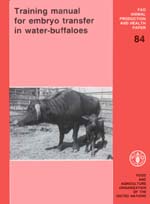
FAO ANIMAL PRODUCTION AND HEALTH PAPER 84
 |
Training manual for embryo transfer in water-buffaloes |
Cover photo: The world's first buffalo Calf born by embryo transfer on 18 March 1983 at the University of Florida and his recipient dam (Photo courtesy of UF Health Science Center Communications)
by
Maarten Drost
College of Veterinary Medicine
University of Florida
Gainesville, Florida, USA
The designations employed and the presentation of material in this publication do not imply the expression of any opinion whatsoever on the part of the Food and Agriculture Organization of the United Nations concerning the legal status of any country, territory, city or area or of its authorities, or concerning the delimitation of its frontiers or boundaries.
The mention of specific companies or of their products or brand names does not imply any endorsement or recommendation on the part of the Food and Agriculture Organization of the United Nations.
M-22
ISBN 92-5-102807-9
All rights reserved. No part of this publication may be reproduced, stored in a retrieval system, or transmitted in any form or by any means, electronic, mechanical, photocopying or otherwise, without the prior permission of the copyright owner. Applications for such permission, with a statement of the purpose and extent of the reproduction, should be addressed to the Director, Publications Division, Food and Agriculture Organization of the United Nations, Via delle Terme di Caracalla, 00100 Rome, Italy.
This manual is intended as a user's guide for the collection and transfer of buffalo embryos. Most of the techniques are based on the author's own experience and were adapted from the same techniques in cattle. Where necessary, specific differences between buffaloes and cattle are pointed out.
For the advanced procedures of cryopreservation, embryo splitting and embryo sexing, the reader is referred to the FAO training manual for bovine embryo transfer, by Dr George E. Seidel, Jr., to which this manual serves as a supplement.
Individuals with experience in buffalo breeding and with a basic understanding of reproductive physiology as well as reproductive endocrinology, and who possess reasonable artificial insemination and rectal palpation skills, should be able to master the techniques of embryo collection and transfer by following the procedures out-lined in this manual. Exercises to perfect such skills are provided in Recommended exercises to master embryo transfer skills.

FOOD AND AGRICULTURE ORGANIZATION OF THE UNITED NATIONS
Rome, © FAO 1991
Hyperlinks to non-FAO Internet sites do not imply any official endorsement of or responsibility for the opinions, ideas, data or products presented at these locations, or guarantee the validity of the information provided. The sole purpose of links to non-FAO sites is to indicate further information available on related topics.
PHYSIOLOGY AND ENDOCRINOLOGY OF THE OESTROUS CYCLE
OESTRUS DETECTION AND INSEMINATION
EMBRYO HANDLING AND EVALUATION
RECIPIENT SELECTION AND SYNCHRONIZATION
DONOR AND RECIPIENT AFTER-CARE
RECOMMENDED EXERCISES TO MASTER EMBRYO TRANSFER SKILLS
Appendix 1
Sources of information
Appendix 3
Comparison of embryo transfer results
between buffaloes and cattle
Table 1
Superovulation treatments with follicle-stimulating
hormone in the buffalo
Table 2
Superovulation treatment with pregnant
mare serum gonadotrophin in the buffalo
Table 3
Modified Dulbecco's phosphate-buffered
saline solution
Table 4
Effect of embryo quality on the
pregnancy rate in cattle
Figure 1
Schematic representation of the oestrous cycle
Figure 2
Equipment for non-surgical embryo recovery
Figure 3
Location of the balloon of the recovery
catheter at the base of the uterine horn
Figure 4
Diagrams of normal, excellent quality
embryos at different stages of development
Figure 5
Diagrams of good quality embryos
Figure 6
Diagrams of fair quality embryos
Figure 7
Diagrams of poor and very poor quality embryos
Figure 8
Equipment for embryo searching
Figure 9
Searching grid-bottomed dish under
stereomicroscope
Figure 10
Equipment for non-surgical embryo transfer
The author is indebted to Mr A.P. Leonards and Dr W.S. Cripe, North American pioneers in the field of water-buffalo production, for their generous support and constant encouragement.
He also wishes to thank Ms N.J. Drost for the figures, Ms B. Smerage for the typing of the manuscript and Dr Hock Seng Tan of the Universiti Pertanian (University of Agriculture) Malaysia for reviewing the manuscript.